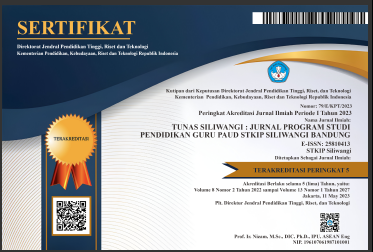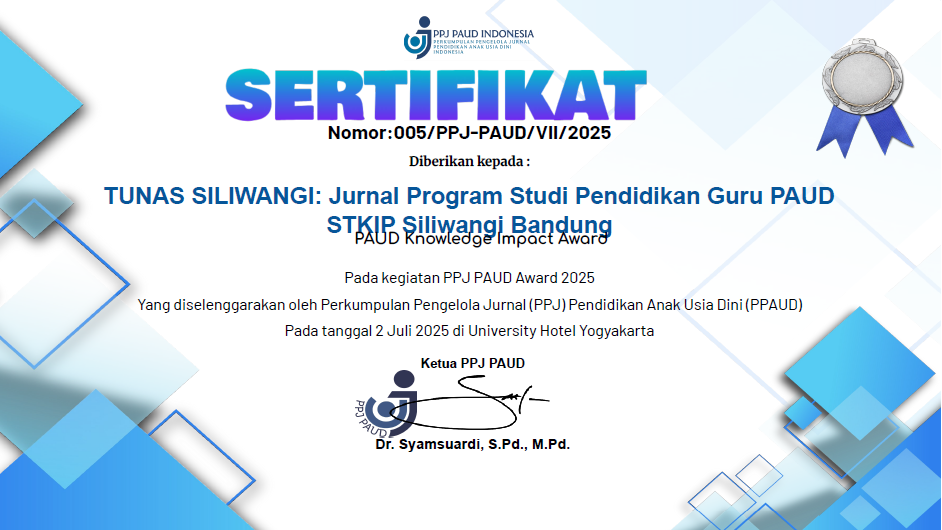DEVELOPING STUDENT’S SELF-ESTEEM IN SPEAKING USING GAMIFICATION APPROACH OF KINDERGAR-TEN STUDENT IN ESL CLASS
DOI:
https://doi.org/10.22460/ts.v9i1.3807Abstract
Children interact with other children, their parents, and other adults as they acquire language. A child can readily acquire two or more languages at once as long as they are conversing with speakers of those languages on a regular basis.. The purpose of this study is to investigate the connection between the use of offline games and young students' self-esteem in speaking English. The researchers' interpretation of the children's written material served as the foundation for the majority of this study's conclusions. In terms of enhancing self-esteem, the data analysis showed numerous evident benefits for all students. The students were free to exercise their independence and display qualities about themselves. ESL students had the same opportunity to compete with their classmates for the limited time that they took part in these activities. This study used a qualitative approach and conducted a pilot test on pre-school students. This research was conducted at Learning Tots Kindergarten located on Sri pohaci Street, Bandung, Indonesia. The study was conducted on 19 students of Learning Tots Kindergarten. The students were given time to play for 30-60 minutes every day for 2 weeks. The games included matching, bingo, and charades. The study was distinctive in that the students produced written summaries of the game events. The basis of this study's data gathering is qualitative information obtained from observations and conducted interviews. This research was conducted using qualitative methods. Where data analysis is based on interviews with research subjects regarding the impression they feel after playing the game. Furthermore, the researcher also saw and analyzed the students' behavior through observation techniques
References
Abazaoğlu, İ., Yıldırım, O., & Yıldızhan, Y. (2015). An overview on the early child-hood
education. Journal of Research in Education and Teaching, 4(1), 411-423.
Ahmadi, M. R. (2017). The impact of motivation on reading comprehension. Internat
ional Journal of Research in English Education, 2(1), 1-7.
Amabile, T. M. (2018). Creativity in context: Update to the social psychology of crea-tive
ty. Routledge.
Andrade, A., Cruz, W. M. D., Correia, C. K., Santos, A. L. G., & Bevilacqua, G. G. (2020). Effect of practice exergames on the mood states and self-esteem of kind
ergarten boys and girls during physical education classes: A cluster-randomized
controlled natural experiment. Plos one, 15(6), e0232392.
Bana, S., Sajedi, F., Mirzaie, H., & Rezasoltani, P. (2017). The efficacy of cognitive beh
avioral play therapy on self esteem of children with intellectual disability. Iranian
Rehabilitation Journal, 15(3), 235-242.
Basabas, M. C., & Sibley, C. G. (2020). It's All Just Fun and Games... Right? Habitual
Gaming Links with Body Dissatisfaction, Psychological Distress, and Lower Self
-Esteem. New Zealand Journal of Psychology, 49(2).
Batubara, F., Derin, T., Putri, N. S., & Yudar, R. S. (2020). Five factors influencing the
students’ motivation to learn English as a foreign language: a closer look into mon
tessori classroom environment. REiLA: Journal of Research and Innovation in Lan
guage, 2(2), 76-84.
Baquedano-López, P., Alexander, R. A., & Hernández, S. J. (2013). Equity issues in par
ental and community involvement in schools: What teacher educators need to know. Review of research in education, 37(1), 149-182.
Bishop, J. C. (2016). ‘That's how the whole hand-clap thing passes on': Online/Offline
Transmission and Multimodal Variation in a Children's Clapping Game. In Chil-dren's Games in the New Media Age (pp. 53-84). Routledge.
De Wilde, V., Brysbaert, M., & Eyckmans, J. (2020). Learning English through
out-of-school exposure. Which levels of language proficiency are attained and
which types of input are important?. Bilingualism: Language and Cognition, 23(1),
-185.
Dörnyei, Z., & Chan, L. (2013). Motivation and vision: An analysis of future L2 self
images, sensory styles, and imagery capacity across two target languages. Lang
uage learning, 63(3), 437-462.
Getie, A. S. (2020). Factors affecting the attitudes of students towards learning English
as a foreign language. Cogent Education, 7(1), 1738184.
Hoang, V. Q. (2021). The differences of individual learners in second language acquisi
tion. International Journal of TESOL & Education, 1(1), 38-46.
Huang, C. L., Yang, S. C., & Chen, A. S. (2015). Motivations and gratification in an
online game: Relationships among players' self-esteem, self-concept, and interper-sonal relationships. Social Behavior and Personality: an international journal, 43(2), 193-203.
Idriyani, N., Azizah, N., Sumiati, N. T., Adriani, Y., & Baidun, A. (2022, February).
Problematic Internet Use and Analysis Factor Affecting with Multiple Regression. In 2022 International Conference on Science and Technology (ICOSTECH) (pp. 1-6). IEEE.
Ingram, J., & Cangemi, J. (2019). Video games: Motivation, effects, and clinical imply
cations on self-esteem. College Student Journal, 53(1), 1-12.
Livingstone, S., Marsh, J., Plowman, L., Ottovordemgentschenfelde, S., & Fletcher-Wat
son, B. (2014). Young children (0-8) and digital technology: A qualitative explora-tory study-national report-UK.
Melani, B. Z., Roberts, S., & Taylor, J. (2020). Social emotional learning practices in
learning English as a second language. Journal of English Learner Education, 10(1), 3.
Mogonea, F- R. and Mogonea, F. (2014). The role of the family in building adolescent’s
self-esteem. Procedia: Social and Behavioral Sciences, 127, 189-193
Powell, S., & Smith, K. (Eds.). (2017). An introduction to early childhood studies. Sage
Saracho, O. N. (2013). An integrated play-based curriculum for young children.
Routledge.167-171.
Downloads
Published
Issue
Section
License
Copyright (c) 2025 anita anggraeni, Anggy Pradita

This work is licensed under a Creative Commons Attribution-ShareAlike 4.0 International License.
The author is responsible for acquiring the permission(s) to reproduce any copyrighted figures, tables, data, or text that are being used in the submitted paper. Authors should note that text quotations of more than 250 words from a published or copyrighted work will require grant of permission from the original publisher to reprint. The written permission letter(s) must be submitted together with the manuscript.






